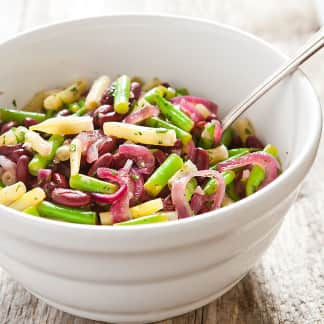Reviews You Can Trust.
See Why.
Red Wine Vinegar
Does aging make a difference in vinegar, or does it all boil down to the grapes you start with?
Editor&aposs Note:UpdateNovember 2015
Top Pick

WINNERLaurent du Clos Red Wine Vinegar
Sign up for the Well-Equipped Cook newsletter
Shop smarter with our ATK Reviews team's expert guides and recommendations.
What You Need to Know
Lately, choosing red wine vinegar at the supermarket gives me the same nervous feeling as trying to pick the right wine for dinner guests. As with balsamic vinegars, the number of red wine vinegars in the condiment aisle has exploded in the past decade. I can choose between brand-name vinegars my mother has used for years and newer ones that boast impressive European pedigrees. Is French better than American? Does aged red wine vinegar provide more depth of flavor? Will a pan deglazed with vinegar that began life as a Zinfandel or Pinot Noir create a sauce that’s more piquant than one flavored with vinegar simply labeled “red”? Considering that some vinegars cost less than 20 cents per ounce, are the ones that cost four or five times as much actually worth the money?
We last tasted red wine vinegars in 2003. Given the proliferation of options since, we decided that it was time to take a fresh look.
How Wine Vinegar is Made
Food scientist Harold McGee aptly calls vinegar “the natural sequel to an alcoholic fermentation.” For centuries, humankind supplied the wine, and nature provided it with bacteria (Acetobacter aceti), which, with the help of oxygen, metabolizes wine’s ethyl alcohol and converts it into the acetic acid that gives vinegar its distinctive sharp scent and mouth-puckering flavor. Today, most commercial red wine vinegars are produced via two distinct methods. The first, the Orléans method, was developed in the 14th century. To start fermentation, oak barrels of wine are inoculated with a “mother of vinegar”—a cellulose glob loaded with acetic acid bacteria from an established vinegar. Periodically, vinegar is drawn off and fresh wine added, and the process continues until all the alcohol is converted into acetic acid. Some argue that this method makes for a more flavorful wine vinegar because it gives the flavor compounds time to develop and mature. But it’s also expensive, since it takes months before the vinegar is ready for the market.
In the second, more modern method, wine and bacteria are put in an acetator, a stainless-steel machine that rapidly circulates oxygen through red wine to feed the bacteria. This method converts alcohol into acetic acid in about a day, although some of these rapidly produced vinegars are then put in barrels for additional aging and, presumably, improved flavor.
Domestic varieties of red wine vinegar are typically just 5 to 6 percent acetic acid, while imports are usually in the 7 percent range; the strength is determined by a dilution with water. But the unique flavor profile of a vinegar is influenced not only by acetic acid but also by naturally occurring flavor compounds from the base wine, as well as by new compounds created during the production process. The question was, which of these factors would actually make a difference to our tasters?
Tasting Red Wine Vinegars by Themselves
We asked 21 staff members to taste and rate 10 red wine vinegars, selected from a list of top-selling national supermarket brands. Most cooks don’t do shots of vinegar unless they’re masochists, but I was curious to learn if we’d get some early preferences right out of the bottle. I assumed that tasters would be partial to the vinegars that were sweet and less harsh, since they’d be tasting these potent substances straight. In fact, the favorite in this round fell right in the middle of the rankings for sweetness and harshness. Tasters, it seemed, liked full flavor and a little sharpness.
While I wasn’t confident that we had a front-runner yet, the plain tasting did reveal that some of the vinegars had unpleasant off-flavors and aromas, the most common being the smell of nail polish remover, or acetone. This was not surprising, since any traces of alcohol left in vinegar will bond chemically with acetic acid to create ethyl acetate, a compound that has the same distinctive scent as the acetone found in nail polish remover. “A little bit is OK,” said Mary Ellen Camire, a professor of food science and nutrition at the University of Maine, explaining that acetate can give vinegar a pleasing fruitiness. “But too much can indicate a production failure.”
Tasting Red Wine Vinegars in Vinaigrette
Next we tasted the vinegars as they would actually be used—in a simple vinaigrette served with butter lettuce and in pickled onions. Surprisingly, some of the harsher vinegars, which had made tasters choke in the plain tasting, were experienced as relatively sweet in the vinaigrette. How could this be?
I recalled that the mayonnaise we had used to help emulsify the vinaigrette contained a small amount of sugar. Our science editor confirmed that the strong, highly acidic vinegars were acting synergistically with this sugar to heighten its sweet taste. Less acidic vinegars, on the other hand, were being pushed into the background, allowing the strong flavor compounds in the extra-virgin olive oil and the mustard to mask sweetness. This told me that a good vinegar needs some muscle in the form of acidity to tease out all the flavors from the bunch.
But in the end, these highly acidic vinegars lost the battle with our tasters. The most expensive of the supermarket brands ended up tied for last place with the other most acidic entry. The majority of tasters simply found them too harsh, especially when sampled plain or in pickled onions. However, since they scored well in our vinaigrette tasting, they might be worth buying if you like a strong, bracing vinegar to dress your salads.
At the top of the heap, a French import knocked our former favorite down a couple of notches with its crisp red wine flavor balanced by stronger than average acidity and subtle sweetness. While this vinegar gets its start in an acetator and then is aged in wooden barrels for two months before bottling, we weren’t convinced that aging was the reason that our tasters gravitated toward this brand. Several of our lowest-ranking vinegars were also aged.
Grape Blends are a Good Thing
There is one characteristic shared by all three top vinegars: They’re blends. One is made from a mix of red and white vinifera grapes, another adds an aged vinegar sourced from Spain to its domestically produced vinegar, and our former favorite is created from a combination of sweet Concord grapes and winy vinifera-type grapes. (It’s worth noting that our favorite high-end vinegar adds Bing cherry juice to heighten the flavor of its base vinegar.) Multiple varieties of grapes create vinegar with a complex and pleasing taste—aging is not necessarily required.
Our Favorite Red Wine Vinegar
For everyday red wine vinegar, our winner is hard to beat. At 35 cents per ounce, it’s not the least expensive brand we tasted, but that’s a reasonable price for a vinegar that doesn’t compromise on flavor.
California, Meet France
We set up a challenge between our new favorite supermarket brand of red wine vinegar, Laurent du Clos (35 cents per ounce), and our longtime gourmet favorite, O Zinfandel ($1.18 per ounce). In blind tastings, we sampled them plain, in vinaigrette, and in pickled onions. Although O Zinfandel won, it wasn’t a landslide, with Laurent du Clos receiving high marks for its pleasing wine flavor and balanced acidity. At $7.99 for a 6.8-ounce bottle, O is nice to have on hand when you need a spoonful to dress a salad, but if you require more than that for a recipe, you’ll get excellent flavor—and save a few bucks—with our supermarket pick’s bigger bottle and smaller price tag.
America's Test KitchenWatch Now
Everything We Tested
Recommended

WINNERLaurent du Clos Red Wine Vinegar

Pompeian Gourmet Red Wine Vinegar
Recommended with reservations

Spectrum Naturals Organic Red Wine Vinegar

Heinz Gourmet Red Wine Vinegar

Holland House Red Wine Vinegar

Regina Red Wine Vinegar

Colavita Red Wine Vinegar

Star Red Wine Vinegar

Lucini Pino Noir Italian Wine Vinegar

Monari Federzoni Red Wine Vinegar
*All products reviewed by America’s Test Kitchen are independently chosen, researched, and reviewed by our editors. We buy products for testing at retail locations and do not accept unsolicited samples for testing. We list suggested sources for recommended products as a convenience to our readers but do not endorse specific retailers. When you choose to purchase our editorial recommendations from the links we provide, we may earn an affiliate commission. Prices are subject to change.
Reviews You Can Trust
The mission of America’s Test Kitchen Reviews is to find the best equipment and ingredients for the home cook through rigorous, hands-on testing. Have a question or suggestion? Send us an email at atkreviews@americastestkitchen.com. We appreciate your feedback!
Reviews You Can Trust.
See Why.




























